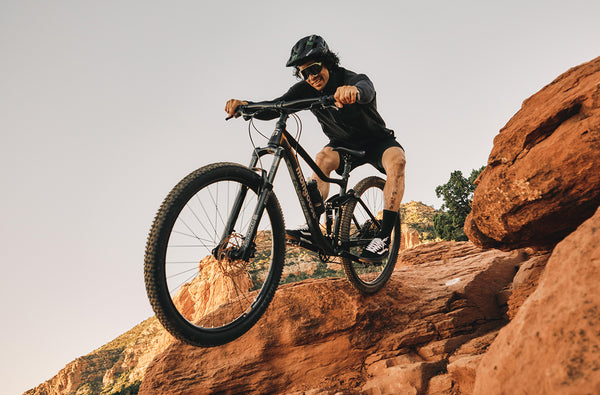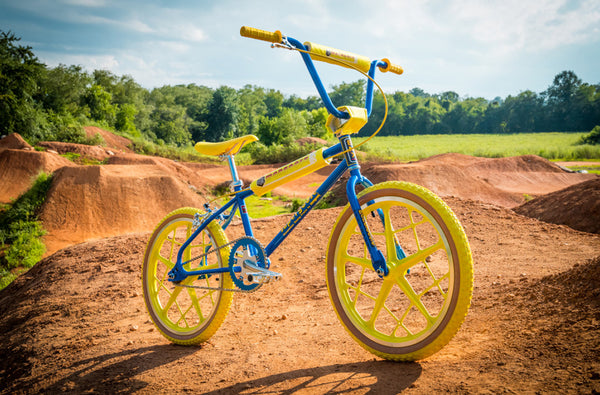
What’s up, trail newbies? We heard that you’re just getting started with mountain biking, and we couldn’t be more stoked to welcome you to the sport! There’s really nothing like getting outdoors, experiencing the local trails, and enjoying nature… all on a bike! At the same time, mountain biking comes with responsibilities like any other sport. There are a few best practices and etiquette rules every rider should know to make sure they’re respecting themselves, their fellow trail users, and the trail itself. Let’s dive in and make sure you’re ready to ride responsibly!
1. Know Your Bike
As a mountain biker, your responsibility extends beyond just having a blast on the trail. It’s about being a steward of the terrain, respecting other trail users, and maintaining control over your bike. The first way to make sure you can do all that is to know your bike! Get used to the controls so you have a feel for braking and shifting. Also, make sure you have the right kind of bike for the terrain you’re riding on. Really rough trail? You might need a full-suspension bike. If you’re just hitting up some singletrack, a hardtail can do nicely. Alternatively, if you’re riding out in the snow you may need a fat tire bike. Having the right bike for the ride and knowing how to handle it not only maximizes your own fun but ensures you can respect the trail and other riders too.

2. Wear Proper Safety Gear
When preparing for your ride, wearing the right protective equipment is non-negotiable. A helmet is the most important piece of safety gear and should always be worn to protect that dome! In addition, gloves, elbow pads, knee pads, and sturdy footwear will help protect you from falls, especially when tackling difficult or downhill terrain. A riding jacket and hydration pack are also crucial for long rides.
3. Plan Your Rides
Before you head out, preparation is essential. Check to make sure your bike is in good condition, especially the brakes and tires, which are crucial for maintaining control on various terrains. Be sure to make sure all the parts are bolted down tight and you have enough air in your tires, especially if you haven’t been for a ride in a while.
Also, you should always inform someone about your riding plans, route, and expected return time, especially if you’re heading into remote areas or you’ll be away for a long time.
4. Understand the Trails
Trail conditions can change depending on the weather and the time of year. After it rains, trails can become muddy and slippery, which can mess with your ability to maintain control and avoid skidding. Riding on muddy trails not only risks injury but can damage the trails by leaving ruts or causing erosion. Pro rider Brandon Hopkins put it nicely.
Riding trails when they are wet is a big no-no. Always check trail statuses.
Brandon Hopkins
Each trail system has its own set of rules. Before heading out, take time to familiarize yourself with the local guidelines. Some trails have specific times when biking is allowed, others may have restrictions on certain bikes, and many offer recommendations for safe trail usage. Pro rider Greg Watts offered some words of wisdom on this subject as well.
Be respectful of the work because it took a lot. Always ask who built the trail and if it’s ok to ride and thank them for their service.
Greg Watts
If you're riding in a bike park, there may be additional safety measures to follow. Many parks have signs indicating specific paths for different levels of difficulty, so choose the right trail for your skill level to ensure both your safety and enjoyment. If you're ever unsure about any trail regulations, don't hesitate to ask park staff for clarification.

5. Ride Within Your Limits
Don’t overdo it! Part of riding responsibly is knowing your limits and staying within them. It’s safer for you and more courteous of other riders. Oh, and it’s way more fun that way.
Fortunately, riding within your limits is easy, since most trails are rated for difficulty. These indicators are commonly found on trail maps or signs to let you know what you’re signing up for.
• Green (Easy): These trails are great for beginners with gentle slopes, minimal technical features, and smoother paths making your rides easy and enjoyable.
• Blue (Intermediate): On these trails, you’re looking at moderate climbs and descents. You might also come across roots and some rocky sections, and technical challenges that require basic bike handling skills. There may be some jumps but usually without gaps between the takeoff and landing.
• Black (Difficult): Intended for experienced riders with advanced technical skills. Here you will potentially find steep drops, large rock gardens, tight turns, and jumps with gaps between the takeoff and landing.
If you’re just starting out, it’s best to stick to green trails and build your skills for a while. Brandon Hopkins once again put it best.
Ride within your skillset and if the opportunity is given, take skills clinics to help learn some of those fundamental skills that you can apply to the trail and help build that confidence.
Brandon Hopkins

6. Stay on Designated Trails
Mountain biking is an awesome opportunity to enjoy the beauty of nature, but it's essential to preserve the habitats we ride through. Stick to designated trails and avoid creating new paths through undisturbed terrain. Straying off the trail not only harms plants and animals but can also contribute to soil erosion. If you encounter wildlife, keep your distance and avoid disturbing them. Don’t approach them to take pics or videos! Always respect the environment by ensuring that your actions do not leave a lasting negative impact.
7. Yield to Non-Bikers
Trails are often multi-use, meaning they’re shared with other outdoor enthusiasts, including hikers, horseback riders, and sometimes trail runners or wildlife watchers. As a mountain biker, it’s important to approach these encounters with courtesy and respect. Yielding to non-bikers is crucial not just for their safety, but for keeping the trail experience smooth for everyone. When riding up from behind another trail user, offer a friendly “on your left” so you don’t surprise them.
8. Stay Alert and Communicate With Other Riders
Respecting fellow riders is essential for a smooth and enjoyable ride. Uphill riders have the right of way, so be sure to yield to them when descending. If you need to stop for a break, pull off the trail and let other riders pass safely. Always avoid obstructing the trail, which could force others to swerve unexpectedly to avoid hitting you.
Many trails are shared with other users, and proper trail etiquette helps maintain harmony. On shared trails, be mindful of your speed and position. Don’t ride super close to other riders, since collisions can (and do) happen. Remember to yield to slower riders and to give enough space to pass safely. Also, avoid riding in large groups on narrow trails, since it can make it difficult for others to get around you. We like how pro rider Matty Cranmer puts it.
The trails are nature’s playground, and they’re built for a good time but you need to be aware of your surroundings. Remember that there are others moving slower or faster than you who want to have a good time too.
Matty Cranmer

9. Know Basic Trailside Repairs
Sometimes things go wrong when you’re riding, and you’re stuck on the side of the trail until you can get the bike working again. That’s why it’s important to know how to fix minor issues like flat tires or slipped chains yourself. Always carry a repair kit that includes spare tubes, a pump, and tools for quick fixes while on the trail. You don’t want to get stuck out there or have to cut a ride short!
10. Leave No Trace
Just like in hiking, camping, and other outdoor pastimes, it’s important to leave no trace when you go mountain biking. If you come across an obstacle, such as a fallen tree or large rock, report it to trail management rather than trying to clear it yourself. Carry out any trash you bring in and never, ever litter! Leaving no trace ensures that others can enjoy the trail as much as you did, and that’s awesome.
Now Get Out There and Get Dirty!
By embracing the responsibility of a mountain biker and following these guidelines, you contribute to a safer, more enjoyable experience for all trail users. Be sure to ride within your limits, respect the trail, and most importantly—enjoy the thrill of tearing it up responsibly!

